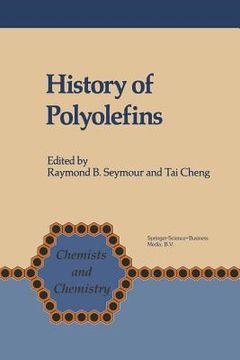Compartir
History of Polyolefins: The World's Most Widely Used Polymers (en Inglés)
Seymour, F. B. ; Tai Cheng (Autor)
·
Springer
· Tapa Blanda
History of Polyolefins: The World's Most Widely Used Polymers (en Inglés) - Seymour, F. B. ; Tai Cheng
$ 161.04
$ 169.99
Ahorras: $ 8.95
Elige la lista en la que quieres agregar tu producto o crea una nueva lista
✓ Producto agregado correctamente a la lista de deseos.
Ir a Mis ListasSe enviará desde nuestra bodega entre el
Lunes 10 de Junio y el
Martes 11 de Junio.
Lo recibirás en cualquier lugar de Estados Unidos entre 1 y 3 días hábiles luego del envío.
Reseña del libro "History of Polyolefins: The World's Most Widely Used Polymers (en Inglés)"
The word Polyethylene was probably first pronounced in a lecture which M. P. E. Berthelot delivered on April,27, 1863 to the Chemical Society in Paris, reporting on the "polymerization" of various simple organic compounds (1). Much later this work appeared twice in the literature before the classical ICI breakthrough in the 1930's which is so colorfully described in Ballard's lecture. Once it came up at the end of the last century when H. von Pechmann obtained "a white flocculant material" from the decomposition of diazomethane which, one year later, was termed to be "polymethylene" - (CH ) - from E. Bamberger 2 and F. Tschiemer (1). At that time the investigators were disappointed about this product because it was not what they had expected to find in their experiments. As a result any further work was discontinued. The second time that the word polyethylene appeared in the literature to describe a "white solid powder" was in 1930 when C. S. Marvel and M. E. P. Friedericks (2) attempted to prepare alkylated As compounds in which all five valencies were covalently bonded to five monovalent-aTkyl groups. They reacted Tetra-ethyl-arsenium bromide with butyllithium and expected to get tetra ethyl butyl arsenium. Instead they obtained LiBr + AsEt3 + gaseous products. Delicate and somewhat time-consuming analysis gave a surprising result: ethane and C 's were there in the 4 expected quantities but ethylene was missing - or almost missing - in the gas mixture.
- 0% (0)
- 0% (0)
- 0% (0)
- 0% (0)
- 0% (0)
Todos los libros de nuestro catálogo son Originales.
El libro está escrito en Inglés.
La encuadernación de esta edición es Tapa Blanda.
✓ Producto agregado correctamente al carro, Ir a Pagar.

